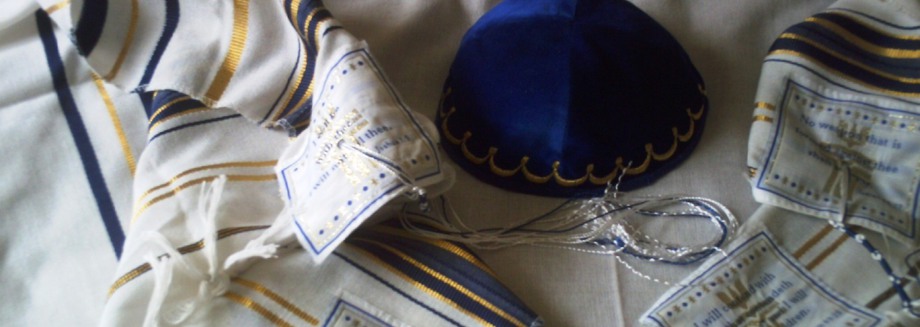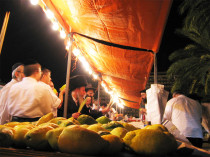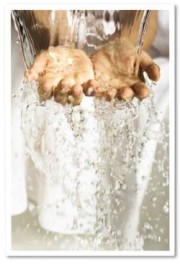
Sukkot
The Feast of Tabernacles, the Temple and the Transfiguration of Yeshua
"Celebrate this as a festival to the LORD for seven days each year. This is to be a lasting ordinance for the generations to come; celebrate it in the seventh month.Live in booths for seven days: All native-born Israelites are to live in booths so your descendants will know that I had the Israelites live in booths when I brought them out of Egypt. I am the LORD your God."
~ Leviticus 23:41-43 ~
The Feast of Tabernacles begins five days after Yom Kippur on the fifteenth of Tishri (September or October), and lasts for eight days. It is a huge change from one of the most solemn holidays in our year to one of the most joyous.
It is the Harvest Festival of Joy!
Biblical Overview
There was a huge contrast to solemnity of Yom Kippur. The people were called to remember:
- The lowliness of their beginning
- The 40-year sojourn in the desert
- That God provides everything we need
To do this, they built and lived in temporary shelters (or 'booths'), and were expected to read Zechariah 14, which talks of God's liberation of the Jewish people in the Land of Israel.
This was one of the 3 pilgrim feasts and the next 3 ceremonies were based around the Temple...
Sukkot and the Temple
The Court of the Women
Within this area, all Jews, male and female, were permitted. Even a ritually unclean Cohen could enter to perform various housekeeping duties. There was also a place for lepers (considered ritually
unclean), as well as a ritual barbershop for Nazirites. In this, the largest of the temple courts, there could be seen constant dancing, singing and music.
The Court of the Israelites
This area was exclusively for Jewish men to enter. The Jewish men could see the animal sacrifices made by the high priest, in the court of the priests. The high priest was leader of the Sanhedrin,
the Jewish government.
The Court of the Priests
The court of the priests was where the sacrificed animals, but only domestic animals could be sacrificed. Also doves and pigeons were sacrificed. The animals had to be younger than one years of age.
Lambs were sacrificed as well, that is why Christians today now call Yeshua the Lamb of God, because he was sacrificed.
The Holy Temple
Between the entrance of the building and the curtain veiling the Holy of Holies were the famous vessels of the temple: the menorah, the incense-burning altar, and various other implements, some of
which were purified with blood.
On the other side of the curtain, within the holy of holies, the chamber was empty; the Ark of the Covenant had disappeared long before.
The Great Illumination took place in the court of the women: 4 golden candelabra, each with 4 golden bowls, are filled with oil.
So brilliant was the light that there was not a court in Jerusalem that was not lit up by it. This reminded them of God's leading in the wilderness with the pillar of fire. It also reminded them of
the Messianic promises for the future when the light of Yahovah would arise upon the land (Isaiah 60:1, 19, 20).
The Talmud (Jerusalem Talmud Sukkot 55 b; Sukkot 53 a) states that on every night of the festive week, 'the Court of the Women' was brilliantly illuminated, and the night spent in joyous celebration.
This 'joy of the feast' remembered the hope of the great harvest when the gentile world would see the light of God – compare with Isaiah 49:6,
"It is too small a thing for you to be my servant to restore the tribes of Jacob and bring back those of Israel I have kept. I will also make you a light for the Gentiles, that you may bring my salvation to the ends of the earth."
Even the windows in the Court of Women were narrow on the inside and wide on the outside (usually the other way round) so as to emphasise that the light of God was to go from inside to outside – the Court of the gentiles – and beyond! And so all this also pointed to 'the days of the Messiah.'
Water Libation (the Drawing of Water)
Water was also an important part of the Feast of Tabernacles. Before the festival, the Rabbis taught on every passage in Scripture dealing with water.
Takes place each morning of the feast whereby a procession, headed by a priest carrying a golden pitcher containing just over two pints, would go to the pool of Siloam.
As he returned via the Water Gate, he was received with a trumpet blast, and with great joy the water was poured into a silver basin on the altar.
This was a reminder that God sustained them with water in the wilderness from the rock, and would yet pour out his blessing upon them. It was also to signify Israel's gratitude for the rain that had produced the harvest, and they would pray for rain in the next year.
The Mishnah tells us
"He that has not beheld the joy of the Drawing of Water has never seen joy in his life."
As the Priest poured out the water over the altar The priest would recite Isaiah 12:1-3...
"And in that day you shall say, O LORD, I will praise you: though you were angry with me, your anger is turned away, and you comfort me. Behold, God is my salvation; I will trust, and not be afraid: for the LORD YAHOVAH is my strength and my song; he also is become my salvation."
Hoshannah Rabbah (The Great Hosanna)
The joy and excitement of the people reached a climax. The Choir of Levites would sing the Hallel (Psalms (113-118)), and the people respond with Hallelujah.
As the singers reached the words of Psalm 118:25-29,
"Blessed is he who comes in the name of the Lord. From the house of the Lord we bless you. The Lord is God, and he has made his light shine upon us. With boughs in hand, join in the festal procession up to the horns of the altar.
You are my God, and I will give thanks; you are my God, and I will exalt you."
People waved their palm branches (now linked with the Lulav) and shouted with joy. As they sung v.26 the godly among them would in their hearts greet the coming Messiah and King to whom they knew these words applied (hence their use in Palm Sunday).
On Rosh Hashanah and Yom Kippur, Hallel is not said at all, because as the Talmud states (Arachin 10b):
"Is it seemly for the king to be sitting on His Throne of Judgment, with the Books of Life and Death open before Him, and for the people to sing joyful praises to Him?"
Yeshua in the Temple at Sukk'ot (John 8:12-59)
It was on this last day, the great day, when Yeshua stood and cried:
"If anyone thirsts let him come to me and drink. He who believes in me, as the scripture has said, out of his heart will flow rivers of living water" (John 7:37-38).
Near the Treasury (cf. Jn. 8:20) in the colonnade around 'the Court of the Women,' in which the receptacles for charitable contributions - the so-called Shopharoth, or 'trumpets' - were placed. The Court of the Women was the common meeting-place of Jewish worshippers
This location was also likely to have prompted Yeshua's initial statement "I Am the light of the world" (v 12) in allusion to one of the great ceremonies of the Feast of Tabernacles.





